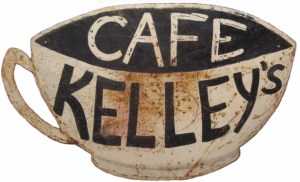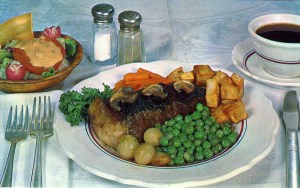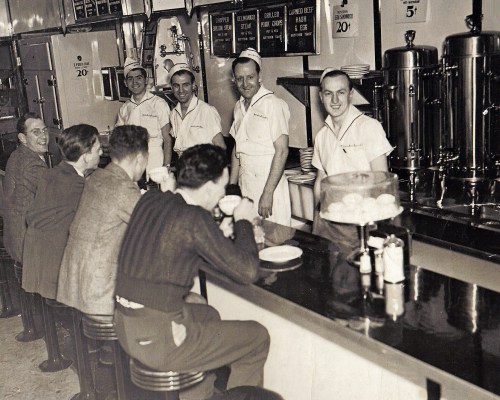 For decades coffee was the beverage most restaurant patrons drank with their meals.
For decades coffee was the beverage most restaurant patrons drank with their meals.
In the Colonial era, though, coffee may have been more of an occasional beverage. Coffee houses were popular gathering spots for business men in the Colonial era and in the early Republic but there is no way of knowing how often coffee accompanied meals in those times. Many coffee houses advertised that it was available all day long, but it’s likely it was outsold by alcoholic drinks.
Then coffee began to gain greater importance as the temperance movement developed in the 1830s. A restaurant owner in Providence RI was an early convert to the role of coffee in reforming heavy-drinking Americans. A religious magazine hailed him for his decision to replace liquor with coffee, stating “If a man must, from habit, drink at 11 o’clock, let him drink ‘Hot Coffee’ and patronize Mr. Dinneford.” In those days 11:00 a.m. was the traditional time for a ‘dram.’
So almost from the beginning coffee was associated with a sober, alert, and morally superior approach to life.
From the mid-19th century into the 1890s most inexpensive restaurants charged 5 cents for a cup, though it might cost a couple of cents more or less. Move up a step to a higher grade eating place, such as Mouquin’s, a popular French table d’hôte in New York City, and a cup would cost 10 cents. Luxury restaurants of the 1890s, such as Delmonico’s, were likely to charge 25 cents for coffee, a sum that would buy a whole dinner in a common lunch room.
The importance of coffee to restaurants grew in the 20th century, especially at popular-priced eateries where the price of a cup remained 5 cents. By the early 1920s, the amount of coffee imported into the U.S. had more than tripled since 1880. At “quick lunch” places, individual table & chair combos that looked like school desks were designed with a hole in the top to hold the all-important coffee mug. Already by 1904, some horse-drawn lunch wagons provided cardboard containers for coffee orders to go.
 Restaurant proprietors and customers alike agreed that “coffee makes the restaurant” and that you could tell a good restaurant by its coffee. Even when sold at a low price it was profitable, especially at lunch counters where service costs were low. Most diners ordered coffee with their meals in the 1920s, even at the ritzy Waldorf Astoria. No one, it seemed, cared that famous French chef Auguste Escoffier had laid down the rule, “Never serve coffee except at the end of the meal.”
Restaurant proprietors and customers alike agreed that “coffee makes the restaurant” and that you could tell a good restaurant by its coffee. Even when sold at a low price it was profitable, especially at lunch counters where service costs were low. Most diners ordered coffee with their meals in the 1920s, even at the ritzy Waldorf Astoria. No one, it seemed, cared that famous French chef Auguste Escoffier had laid down the rule, “Never serve coffee except at the end of the meal.”
In the 1930s and 1940s, a nickel a cup didn’t seem enough to many restaurateurs who raised their prices to 10 cents. Those that did not had reason to regret it in 1944 when the war caused the federal government to order that restaurants not charge more for coffee that they had in October 1942. For most places this meant 10 cents, but chains such as the Automat, Bickford’s, Thompson’s, B&G Sandwich Shops, and the Waldorf System were stuck with nickel-a-cup until late in 1950.
Prices continued to tick upwards after that. By the mid-1970s 25 cents a cup was standard in the average restaurant. (Even then, there were customers who bristled at paying more than 5 cents!) Often restaurants softened the blow of price increases by offering free refills to those ordering full meals. Still prices rose, and even chains such as Wendy’s raised their price to 30 cents while Friendly’s went up to 35 cents in 1977. Ten years later, one dollar a cup was commonplace.
 In the 1970s and 1980s, higher priced coffee beans, along with fast food chain competition, and the rise of soft drinks with meals reduced the popularity of coffee and dealt a blow to coffee shop restaurants. Coffee shops had been the fifth most popular type of eating place according to a 1976 National Restaurant Association survey, but by the mid 1980s they were slipping badly. Philip Langdon, author of a book on chain restaurants titled Orange Roofs and Golden Arches, observed that many coffee shops had restyled themselves as “family restaurants” in an attempt to draw the dinner crowd.
In the 1970s and 1980s, higher priced coffee beans, along with fast food chain competition, and the rise of soft drinks with meals reduced the popularity of coffee and dealt a blow to coffee shop restaurants. Coffee shops had been the fifth most popular type of eating place according to a 1976 National Restaurant Association survey, but by the mid 1980s they were slipping badly. Philip Langdon, author of a book on chain restaurants titled Orange Roofs and Golden Arches, observed that many coffee shops had restyled themselves as “family restaurants” in an attempt to draw the dinner crowd.
Around the same time a series of SCTV comedy sketches made fun of the mythical polka-loving residents of Leutonia and their fondness for “cabbage rolls and coffee,” marking a new attitude to coffee with lunch or dinner that branded it as the choice of unhip elderly diners.
Coffee retains its popularity as a stand-alone beverage today, but less as an accompaniment to meals. Gone are the days when Maxwell House coffee and Cory coffeemakers reigned – when 90% of restaurant customers ordered coffee with their meals (1935) – and when the trio “Cleanliness, Comfort, Coffee” were enough to assure a restaurant of success (1955).
© Jan Whitaker, 2016













 It's great to hear from readers and I take time to answer queries. I can't always find what you are looking for, but I do appreciate getting thank yous no matter what the outcome.
It's great to hear from readers and I take time to answer queries. I can't always find what you are looking for, but I do appreciate getting thank yous no matter what the outcome.



Feel like coffee is still king Cory Corporation was purchased by Aramark to become there coffee division.That division is today the largest office coffee distribution in the US serving over a billion cups a year.
What was the name of the coffee shop on Michigan Ave during the 1960s, O’Connell’s maybe?
I am not sure what you mean by “the coffee shop” on Michigan Avenue as I would think there were many (if you are referring to Chicago), but there was a unit of the O’Connell’s restaurant chain at 618 N. Michigan which closed around the mid-1980s.
That was probably it. I worked for an advertising agency on Fairbanks Court and only went there for morning coffee and I guess that’s why I think of it as a coffee shop. Thank you.
Very lovely and informing article – thank you! Nowadays, though you have another dimension to add – restaurants have become also the subjé of fantasy fiction; they can play kinda huge part of the stories – for example: https://leckerbiss.com/2015/10/31/dinning-like-cersei/
Thanks, interesting angle.
😉 it is GR Martin’s view of the world – but it also tells something…by the way, for me coffee is a desert, like I need one after a good dinner instead of a sweet. Is this also common in the States? I think we copied that habit from the Italians…
Probably not that common — I’d say that most people who order coffee in the U.S. also want dessert — but not unknown.
Great post!
hi Jan! I found your blog via Food Anthropology, the blog of the Society for the Anthropology of Food and Nutrition, in their section ‘what Food Anthropology is reading now” while searching for information about PhD programmes in Food and Nutrition. Your blog is so interesting, and I find this post particularly interesting because I looove coffee ❤ Keep up the great work ~Nina
Thank you!
Jan
I instantly craved a cup of espresso after reading your article. It is brewing as I write.
You’ve taught me a lot about my favorite brew.
Thanks.
Joe
Thanks, Joe. And I didn’t even explore espresso or the fancy coffee dessert drinks — another post!
Great post (as always), Jan! How interesting that coffee took off during temperance era!!!